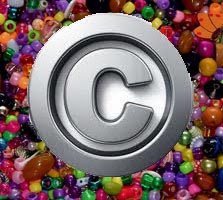 Question: A beading magazine has lots of instructions for making beaded jewelry designs that are purely geometric. The magazine tells readers that they can only use these designs for gifts or personal use (but not to sell). Can the magazine stop me from selling jewelry based on these designs?
Question: A beading magazine has lots of instructions for making beaded jewelry designs that are purely geometric. The magazine tells readers that they can only use these designs for gifts or personal use (but not to sell). Can the magazine stop me from selling jewelry based on these designs?
Answer: We think you can probably sell the designs without incident but our response depends on the uniqueness and novelty of the patterns. Geometric shapes — pentagrams, stars, arrows, rectangles, etc. — are not copyrightable but geometric patterns combining those shapes may be protected. Like many things in copyright there is a spectrum of protection and the most minimal designs are typically afforded the least protection — for example, in one copyright case, the minimalist jeweler Paul Morelli was unable to stop Tiffany’s from selling 17 of his simple designs.
But how do I know what’s protected? Section 503.02(a) of the Copyright Compendium directs the Copyright Office to refuse registration for common geometric shapes. However, Section 503.02(b) permits registration for combinations of sculptural geometric figures if they “consist of something more than the mere bringing together of two or three standard forms or shapes with minor linear or spatial variations.” A 1989 Court of Appeals decision (authored by then-circuit court judge Ruth Bader Ginsberg) summarized some of the cases in which combinations of geometric shapes have achieved protection.
[W]e note that simple shapes, when selected or combined in a distinctive manner indicating some ingenuity, have been accorded copyright protection both by the Register and in court. See, e.g., Soptra Fabrics Corp. v. Stafford Knitting Mills, Inc., 490 F.2d 1092, 1094 (2d Cir.1974) (concluding that fabric design consisting of strip of crescents with scalloping or ribbons and rows of semicircles “constitutes modest but sufficient originality so as to support the copyright”); Tennessee Fabricating Co. v. Moultrie Mfg. Co., 421 F.2d 279, 282 (5th Cir.) (holding that filigree pattern of intercepting 884*884 straight and arc lines “possessed at least the minimal degree of creativity required for a copyright”), cert. denied, 398 U.S. 928, 90 S.Ct. 1819, 26 L.Ed.2d 91 (1970); Concord Fabrics, Inc. v. Marcus Bros. Textile Corp., 409 F.2d 1315, 1316 (2d Cir.1969) (treating as subject to copyright protection fabric design consisting of a circle within a square within a circle); In Design v. Lynch Knitting Mills, Inc., 689 F.Supp. 176, 178-79 (S.D.N.Y.) (upholding copyright of rhomboid pattern on a sweater), aff’d, 863 F.2d 45 (2d Cir.1988).
Can you copy and sell the designs? The magazine’s position seems to be that it will not prosecute infringements for personal or gift use but that it reserves the right to sue over commercial uses. (Absent an end user license agreement (EULA) you have no contractual obligations.) Whether the magazine will pursue you depends on if: (1) the magazine believes its copyright is defensible (Where do the designs fall in the spectrum of geometric designs? Will the copyright claim stand up in court?); (2) the magazine learns of your sale (Where are you on their radar?); and (3) the magazine wants to become embroiled in a legal action (Can it afford the suit? Does it want to litigate against one of its readers?).
